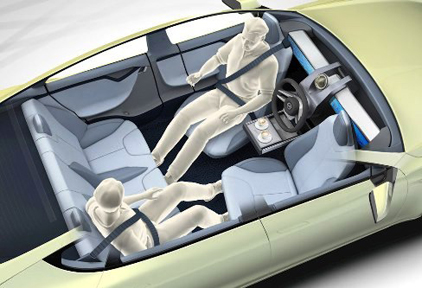A new way to travel
 What
if all trips in a city were carried out by a fleet of self-driving cars
shared by users? A latest transport study explores the potential
outcomes of such a radical upgrade in an urban mobility system. It
concludes that up to 9 out of 10 conventional cars could become
redundant under certain circumstances. What
if all trips in a city were carried out by a fleet of self-driving cars
shared by users? A latest transport study explores the potential
outcomes of such a radical upgrade in an urban mobility system. It
concludes that up to 9 out of 10 conventional cars could become
redundant under certain circumstances.
Vast amounts of public space would be freed for other uses in such a
scenario. However, the total volume of travel increases in most
scenarios and the net benefit of such an urban mobility system upgrade
decisively depends on the choice of vehicle type, the level of
penetration and the availability of high-capacity public transport to
complement the shared self-driving car fleet.
Self-driving cars could take nine out of 10 cars off city streets,
free up more public space for recreational and commercial use, and even
remove the need for expensive rail infrastructure in the future,
according to this new study.
Mobility
In the study on 'How shared self-driving cars could change city
traffic' released on 23 April 2015, researchers from the International
Transport Forum (ITF) at the Organisation for Economic Co-Operation and
Development (OECD) used data modelling techniques to predict how
autonomous cars would change the nature of urban mobility in a
hypothetical mid-sized European city "at some unnamed time in the
future". But we are looking at least 20 years into the future.
As their name suggests, driverless cars can sense road conditions and
navigate without human input. A complex array of radar, global
positioning system (GPS) and computer technology enables autonomous cars
to perform functions such as acceleration, braking, steering, and
indicating independently.
These cars have largely been confined to the realm of research and
testing to date, with companies such as search engine giant Google
developing technology for autonomous electric vehicles and piloting them
on the streets of various American states including Washington DC,
Nevada, Florida, and Michigan.
Tested
European countries, too, have begun to allow these vehicles to be
tested on their roads. Italy, France, Belgium, Sweden, Switzerland and
the United Kingdom are among those who have allowed testing autonomous
cars in some cities. More recently, car manufacturers such as Mercedes
Benz and BMW have also revealed driverless prototypes, with industry
observers predicting that 20 years from today, most new cars will be
driverless.
|

Pic courtesy: Vulcan Post |
This study proposes two interesting ways in which we could share
self-driving electric cars in the near future. The two concepts are
TaxiBot and AutoVot. TaxiBots are self-driving electric vehicles that
can be shared by several people, not unlike some of the shared taxi
services that already exist. AutoVots pick up and drop off single
passengers sequentially. They deliver the same trips as we see today in
terms of origin, destination and timing. Interestingly, the authors of
the study say buses can also be replaced with the TaxiBots, but with the
advances being made in bus technology buses could turn out to be a
better mode of travel. However, this study does not take into
consideration the important aspect of goods transport and we can assume
that trucks and rail will still be needed for that purpose.
Congestion
The best bit about this study is that a large number of cars can be
removed from the cities, without necessarily affecting the number of
trips. This is of course the main cause of traffic congestion. Another
major benefit is that TaxiBots and AutoVots, which can always be in the
move, will need hardly any parking space. Most cities reserve nearly 30%
of their space for parking, which can be freed for other purposes if
parking is minimized. Multi-storey car parks will also not be needed.
The level of technology needed for this type of vehicular fleet is
already within our reach, but the various technologies have to fall into
place and become a cohesive whole. Electric cars are already there and
driverless cars are entering the mainstream gradually, but it will take
some before the traffic management systems can be automated to the level
that can ensure a smooth journey for self-driving cars. Besides, if you
are used to the privacy of a private car, a shared ride may not be all
that appealing. There clearly are physical, infrastructural, social and
even psychological barriers that have to be overcome before this kind of
scheme becomes successful.
In the meantime, electric cars are gathering steam. Google's
revelation that its driverless cars have met with 11 minor accidents has
caused a ripple in the industry, but the good news is that Google and
its cars are learning how to avoid those in the future. It is a learning
curve and we may hear of more such incidents until an almost perfect
system can be formulated. Machines will have to learn to take
split-second decisions of the kind that human drivers do all the time
almost by reflex. With the rights inputs (cameras, radar, lidar etc)
they will get better at this.
In fact, the one question that bothers the car industry and the
insurance industry is just who is responsible if an accident is caused
by a driverless car. Is it the car or the human(s) riding inside ?
Tesla, for one, is working on an interim solution.
Autopilot
The Palo Alto, Calif., electric-car maker soon will begin activating
semi-autonomous features, including the capability to pass other cars
without driver intervention, in its Model S sedans. A driver can trigger
the passing function by hitting the turn signal, according to people
familiar with the technology. That action not only tells the car it can
pass, but also means the driver has given thought to whether the
manoeuvre is safe.
Tesla cars will have an "autopilot" that will handle most driving
duties on the highway and could even come pick you up on private
property with no driver at all. Currently, cars with driver-assistance
features, such as those that keep a car within lane lines, are legal and
typically require the driver to remain actively engaged in the vehicle's
operation. Given the rapid pace of development in the electric and
driverless car sphere, it will be an interesting future ahead for
driverless cars. |

